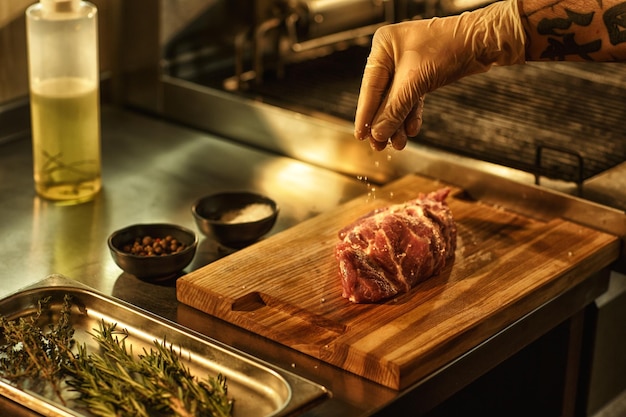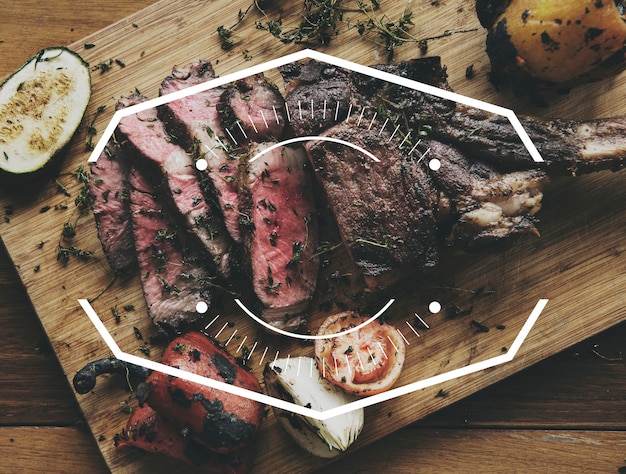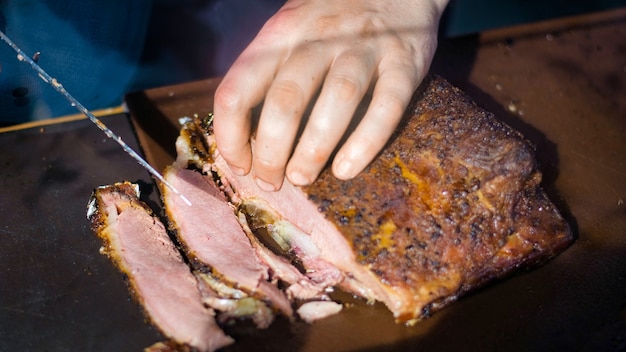Let's face it, there's something truly magical about a perfectly cooked prime rib roast. The rich, savory aroma that fills your kitchen, the irresistible crust that crackles with each bite, and the tender, melt-in-your-mouth meat – it's a culinary experience that's hard to beat. And you know what? You don't need a fancy oven or a fancy grill to achieve this epic feat. Your trusty roaster oven, my friend, is more than capable of handling the job.
I've always been a huge fan of roaster ovens. They're incredibly versatile and perfect for whipping up everything from hearty stews to succulent roasts. When it comes to prime rib, the roaster oven really shines. It distributes heat evenly, ensuring your roast cooks consistently without drying out, leading to a truly satisfying result.
Through years of experimentation and countless delicious meals, I've learned a thing or two about the art of roasting prime rib. So, get ready to join me on this culinary journey as I share my tried-and-true method for creating the most incredible prime rib roast in your roaster oven. Prepare to impress your loved ones (and maybe even yourself) with this simple yet elegant recipe!
Part 1: Selecting Your Prime Rib

The Cut That Makes the Difference
Let's start with the star of the show: the prime rib itself. It's all about picking the right cut for that ultimate roasting experience. My go-to choice is a standing rib roast, often referred to as a "prime rib roast." This beautiful, bone-in cut offers both visual appeal and incredible flavor. The bone, you see, plays a key role in keeping the meat moist during cooking, ensuring a wonderfully succulent outcome.
Size Matters: Feeding the Crowd
Now, when choosing your prime rib, think about the number of people you're planning to feed. A general rule of thumb is to allow about 1 pound of prime rib per person. Of course, if you have a smaller roaster oven, you can always opt for a smaller roast. Don't worry, you can always scale the recipe down to suit your needs.
The Importance of Grade
Once you've found a prime rib that looks fantastic, take a closer look at the label. You'll find the grade of the meat listed there. Prime is the highest grade, followed by Choice and Select. I usually gravitate towards Prime, as it's the most marbled, resulting in a truly tender and flavorful roast. The marbling, those beautiful streaks of fat, contribute to that melt-in-your-mouth texture we all crave.
Part 2: Preparing the Prime Rib for Roasting

Pat It Dry for a Crispy Crust
You've got your prime rib home, and now it's time to get ready for the roasting process. The first step is to pat it dry using paper towels. This simple step helps prevent steaming during cooking, which leads to a beautifully crisp crust. We're all about that perfect balance of tender meat and a fantastically crispy exterior, right?
Seasoning Perfection: Keep it Simple, Keep it Delicious
Here comes the fun part: seasoning! I like to keep things straightforward with a classic blend of salt, pepper, and garlic powder. You can get creative with herbs like rosemary or thyme, but I find that a basic seasoning allows the prime rib's natural flavor to shine through.
Now, when it comes to salt, I like to use a generous amount. This may seem a bit counterintuitive, but trust me on this one. The salt actually helps draw out moisture from the meat, contributing to a stunningly browned exterior and a fantastically flavorful crust. Don't be afraid to be a bit generous with the salt!
Don't Neglect the Fat Cap: Your Secret Weapon
You might be tempted to trim the fat cap off the prime rib, but I highly recommend leaving it on. That fat cap acts like a natural insulator, keeping the meat beautifully moist and tender throughout the cooking process. It also melts during cooking, basting the roast with flavor and resulting in that irresistible golden crust we've been talking about.
Go ahead and leave that fat cap on, but give it a good score with a sharp knife. This will help the fat render more evenly during cooking, contributing to a wonderfully crisp crust.
Part 3: The Roasting Process: A Symphony of Heat and Time

Roaster Oven Prep: Set the Stage
Now, let's get that roaster oven ready for action! I like to line mine with a sheet of parchment paper. This makes for a breeze when it comes to cleanup, and you won't have to worry about the roast sticking. The parchment paper won't affect the cooking process in any way; it simply creates a barrier and ensures even heat distribution.
High Heat for a Stunning Sear
Set your roaster oven to a high temperature, around 450 degrees Fahrenheit (232 degrees Celsius). That initial high heat will help sear the prime rib, creating a beautiful crust that's both visually appealing and bursting with flavor. Once the oven is preheated, carefully place your seasoned prime rib inside.
Time for the Sear: Creating a Flavorful Foundation
Let that prime rib cook at that high temperature for about 15 minutes. This step is crucial for creating a fantastic sear on all sides of the roast, laying the foundation for an incredible taste and texture.
Lowering the Heat for Tenderness
After that initial sear, it's time to dial down the heat. Reduce the temperature to around 325 degrees Fahrenheit (163 degrees Celsius). This lower temperature allows the roast to cook slowly and evenly, ensuring that it stays incredibly juicy and tender. We're aiming for that melt-in-your-mouth experience, remember?
cooking time: Patience is Key
The cooking time will vary depending on the size and thickness of your prime rib. As a general rule, allow about 15-20 minutes per pound for medium-rare. Remember, you're aiming for an internal temperature of 135 degrees Fahrenheit (57 degrees Celsius) for medium-rare.
If you're aiming for medium, cook the roast until the internal temperature reaches 140 degrees Fahrenheit (60 degrees Celsius). For medium-well, cook to 145 degrees Fahrenheit (63 degrees Celsius), and for well-done, cook to 150 degrees Fahrenheit (66 degrees Celsius).
The meat thermometer: Your Culinary Compass
To ensure you achieve the perfect level of doneness, I highly recommend using a meat thermometer. It's the only way to truly know when your roast is cooked to your liking. Always check the internal temperature in the thickest part of the roast, making sure to avoid any bone or fat.
Part 4: The Art of Resting: Letting the Juices Redistribute
Patience is a Virtue (and Essential)
After your prime rib has reached the desired internal temperature, it's crucial to let it rest before carving. This step allows the juices to redistribute throughout the roast, resulting in a more tender and succulent cut. We want every bite to be bursting with flavor, right?
I usually let the prime rib rest for at least 15-20 minutes, covered loosely with foil, before carving. The longer you let it rest, the more the juices will redistribute, leading to a juicier and more flavorful roast. Patience, my friend, is a virtue in the kitchen, and in this case, it will be well rewarded.
Part 5: Carving and Serving: The Grand Finale
Time to Carve: Unveiling the Masterpiece
Your prime rib has rested, and now it's time for the moment of truth – carving. If you're using a standing rib roast, you'll want to carefully remove the bones before carving. Don't worry if you're not sure how to do this; there are plenty of tutorials available online that will walk you through it. It's easier than you think!
Once the bones are removed, you can carve the roast into thin slices. I prefer to carve the slices across the grain, which helps to tenderize the meat even further.
Serving Suggestions: Creating a Feast
Now comes the fun part – serving! I love to serve prime rib with classic accompaniments like mashed potatoes, roasted vegetables, and a rich gravy. That gravy is a must-have, adding a touch of extra flavor and moisture to the roast. It's the perfect finishing touch.
Feel free to get creative with your sides, too! I've been known to serve prime rib with a side of asparagus, roasted brussels sprouts, or even a simple green salad. The possibilities are endless!
Part 6: Troubleshooting Tips: Fixing Those Unexpected Hiccups
Dry Roast: Recovering from a Dry Spell
Let's be honest, sometimes things don't go exactly as planned in the kitchen. If your prime rib turns out a bit dry, don't panic! You can always add some extra moisture by serving it with a rich gravy or a pan sauce. A little creativity can go a long way in turning a seemingly dry roast into a delicious dish.
Overcooked: Salvage That Roasted Treasure
If you've accidentally overcooked the prime rib, don't despair. You can still salvage it by slicing it thinly and using it in a sandwich or a salad. It's not the end of the world! Think of it as a new culinary adventure.
Undercooked: A Quick Fix for a Rare Treat
If the prime rib is undercooked, simply return it to the roaster oven and cook it for a bit longer. Just remember to keep an eye on the internal temperature and check it frequently to avoid overcooking.
Part 7: Variations and Alternatives: Exploring Flavors and Techniques
Herb-Crusted Prime Rib: A Flavorful Twist
For a truly flavorful twist, you can create a delicious herb crust for your prime rib. Simply combine your favorite herbs, like rosemary, thyme, and garlic, with a bit of olive oil and salt. Then, rub the mixture all over the roast before cooking. The aroma alone will have your guests salivating!
Garlic-Rosemary Prime Rib: A Classic Combination
Garlic and rosemary are a classic pairing that always works beautifully with prime rib. You can create a delicious garlic-rosemary rub by combining minced garlic, fresh rosemary, salt, and pepper. Rub the mixture all over the roast and let it sit for at least 30 minutes before cooking. The flavors will meld and create a truly unforgettable taste sensation.
Prime Rib with a Dijon Mustard Glaze: Tangy and Delicious
If you're looking for a more tangy flavor, try a Dijon mustard glaze. Simply combine Dijon mustard, honey, and a bit of garlic powder in a small bowl. Then, brush the glaze over the roast during the last 30 minutes of cooking. The result will be a beautifully caramelized crust and a delicious, tangy flavor.
Part 8: FAQs: Addressing Common Questions
Q1: What temperature should I cook the prime rib to for medium-rare?
A1: Aim for an internal temperature of 135 degrees Fahrenheit (57 degrees Celsius) for medium-rare. If you're aiming for medium, cook the roast until the internal temperature reaches 140 degrees Fahrenheit (60 degrees Celsius). For medium-well, cook to 145 degrees Fahrenheit (63 degrees Celsius), and for well-done, cook to 150 degrees Fahrenheit (66 degrees Celsius).
Q2: How long should I let the prime rib rest after cooking?
A2: I usually let the prime rib rest for at least 15-20 minutes, covered loosely with foil, before carving. This allows the juices to redistribute throughout the roast, resulting in a more tender and succulent cut.
Q3: What are some good side dishes for prime rib?
A3: Prime rib pairs well with classic sides like mashed potatoes, roasted vegetables, and a rich gravy. You can also get creative with your sides and serve it with asparagus, roasted Brussels sprouts, or even a simple green salad.
Q4: What happens if I overcook the prime rib?
A4: If you accidentally overcooked the prime rib, don't fret. You can still salvage it by slicing it thinly and using it in a sandwich or a salad.
Q5: Can I use a different type of oven to cook prime rib?
A5: Yes, you can absolutely cook prime rib in a regular oven. Simply follow the same instructions, adjusting the cooking time as needed. If you have a grill, you can also cook prime rib on the grill, but be sure to use a meat thermometer to ensure that it’s cooked to your liking.
Part 9: Conclusion: Embark on Your Prime Rib Journey
There you have it! My go-to method for cooking the most incredible prime rib in your roaster oven. It's a simple recipe, but the results are truly impressive. So, grab your favorite prime rib, fire up your roaster oven, and get ready to wow your friends and family with this culinary masterpiece. Happy roasting!
Everyone is watching

Prime Rib Roast Cooking Time Chart: Per Pound Guide
Cooking TipsPrime rib roast. Just the name conjures images of lavish dinners, crackling fires, and hearty laughter. It’s ...

How Long to Bake Potatoes in the Oven (Perfect Every Time)
Cooking TipsBaked potatoes are a staple in my kitchen. They're incredibly versatile, delicious, and surprisingly easy to m...

Perfect Rice Every Time: The Ultimate Guide to Cooking Rice
Cooking TipsAs a self-proclaimed foodie, I've always been a bit obsessed with rice. It's the foundation of countless cuisi...

The Ultimate Guide to Cooking Asparagus: Tips, Techniques, and Recipes
Cooking TipsAsparagus. The mere mention of this spring delicacy conjures up images of vibrant green spears, crisp and burs...

Ultimate Guide to Cooking the Perfect Thanksgiving Turkey
Cooking TipsThanksgiving. Just the word conjures up images of overflowing tables laden with delicious food, the scent of r...
